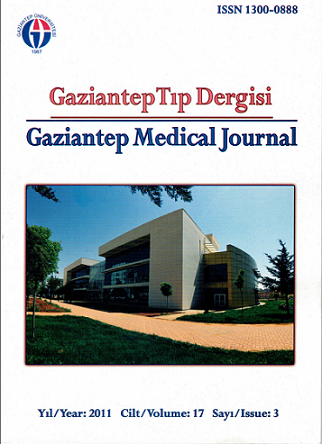Comparison of central corneal thickness, corneal curvature and axial length values in pseudoexfoliation cases with or without cataract
Kataraktlı ve kataraktsız psödoeksfolyasyonlu olgularda santral kornea kalınlığı, korneal kurvatür ve aksiyel uzunluk değerlerinin karşılaştırılması
DOI:
https://doi.org/10.5455/GMJ-30-2011-52Keywords:
Exfoliation syndrome, corneal diseasesAbstract
Pseudoexfoliation (PE) is an age-related condition characterized with production and progressively accumulation of extracellular fibrotic material in ocular tissues. In this study, it was aimed to compare central corneal thickness in terms of average keratometric values and axial length in control group and eyes with PE with or without cataracts. Files of the cases who were admitted to Gaziantep University, Medical Faculty, Ophthalmology Clinic between January 2004 and February 2011, and diagnosed as PE were analyzed retrospectively. All patients were performed a detailed ophthalmologic examination including ultrasonic pachtmetry, automatic keratorefractometry and ultrasonic biometry measurements. Study group was consisted of a total 159 cases with PE (115 cases with cataract and 44 cases with no cataract) and 60 healthy subjects (control group). Mean central corneal thickness value of the cases with PE was 537.20±5.24 microns, axial length values was 23.31±1.03 mm, and mean keratometric values was 44.06±0.24 diopter, while these values for control group were 556.23±13.21 micron, 23.12±0.98 mm, and 44.28±0.65 diopter, respectively. When PE cases and controls were compared, the difference was significant (p<0.05) in terms of central corneal thickness, while there was no difference between groups in terms of average keratometric values and axial length measurements (p>0.05). Mean central corneal thickness value, axial length, and mean keratometric value of the cases with PE cataract were 541.93±48.29 micron, 23.07±1.32 mm, and 44.59±1.29 diopter, respectively. These values were 540.28±4.34 micron, 23.31±1.03 mm, and 44.06±0.24 diopter for the cases without PE cataract. A significant difference was not detected between the cases with and without cataract in terms of average central corneal length, axial length, and keratometric values (p>0.05). Cornea was seen to be thinner in cases with pseudoexfoliation compared to control group. Central corneal thickness measured in these subjects was not detected to be different in terms of average keratometric values and axial length in eyes with or without cataract.
Metrics
References
Arnarsson A, Damji KF, Sverrisson T, Sasaki H, Jonasson F. Pseudoexfoliation in the Reykjavik Eye Study: prevalence and related ophthalmological variables. Acta Ophthalmol Scand 2007;85(8):822-7.
Schlötzer-Schrehardt U, Naumann GO. Ocular and systemic pseudoexfoliation syndrome. Am J Ophthalmol 2006;141(5):921–37.
Ritch R, Schlötzer-Schrehardt U. Exfoliation syndrome. Surv Ophthalmol 2001;45(4):265–315.
Aksoy MD, Yarangümeli A, Gürbüz Köz Ö, Kural G. Fakoemülsifikasyon cerrahisi uygulanan gözlerde glokom ve psödoeksfolyasyon varlığının postoperatif sonuçlar ve komplikasyonlara etkisi. MN Oftalmoloji 2005;12(3):190-5.
Altıaylık Özer P, Altıparmak UE, Şatana B, Aslan BS, Duman S. Psödoeksfolyasyon sendromu olan ve olmayan hastalarda fakoemulsifikasyon sonrası erken dönemde göz içi basınç takibi ve önemi. Glokom-Katarakt 2007;2(4):267-70.
Oltulu R, Kamış Ü, Bozkurt B, Şahin A, Özkağnıcı A. Eksfoliasyon sendromlu gözlerde pupilla genişliğinin fakoemülsifikasyon sırasında oluşan komplikasyonlara etkisi. Türkiye Klinikleri J Ophthalmol 2009;18(2):119-23.
Stefaniotou M, Kalogeropoulos C, Razis N, Psilas K. The cornea in exfoliation syndrome. Doc Ophthalmol 1992;80(4):329-33.
Brooks AM, Gillies WE. Fluorescein angiography and fluorophotometry of the iris in pseudoexfoliation of the lens capsule. Br J Ophthalmol 1983;67(4):249-54.
Schlötzer-Schrehardt UM, Dörfler S, Naumann GO. Corneal endothelial involvement in pseudoexfoliation syndrome. Arch Ophthalmol 1993;111(5):666-74.
Lesiewska-Junk H, Kałuzny J, Malukiewicz-Wiśniewska G. Long-term evaluation of endothelial cell loss after phacoemulsification. Eur J Ophthalmol 2002;12(1):30-3.
Cheng H, Bates AK, Wood L, McPherson K. Positive correlation of corneal thickness and endothelial cell loss. Serial measurements after cataract surgery. Arch Ophthalmol 1988;106(7):920-2.
Gorezis S, Christos G, Stefaniotou M, Moustaklis K, Skyrlas A, Kitsos G. Comparative results of central corneal thickness measurements in primary open-angle glaucoma, pseudoexfoliation glaucoma, and ocular hypertension. Ophthalmic Surg Lasers Imaging 2008;39(1):17-21.
Aghaian E, Choe JE, Lin S, Stamper RL. Central corneal thickness of Caucasians, Chinese, Hispanics, Filipinos, African Americans, and Japanese in a glaucoma clinic. Ophthalmology 2004;111(12):2211-9.
Inoue K, Okugawa K, Oshika T, Amano S. Morphological study of corneal endothelium and corneal thickness in pseudoexfoliation syndrome. Jpn J Ophthalmol 2003;47(3):235- 9.
Alimgil ML, Erda S. Tek taraflı psödoeksfolyasyon sendromlu olgularda kornea endotel ve kalınlık değişiklikleri. Türkiye Klinikleri J Ophthalmol 1995;4(1):52-4.
Wali UK, Bialasiewicz AA, Rizvi SG, Al-Belushi H. In vivo morphometry of corneal endothelial cells in pseudoexfoliation keratopathy with glaucoma and cataract. Ophthalmic Res 2009;41(3):175-9.
Hepsen IF, Yağci R, Keskin U. Corneal curvature and central corneal thickness in eyes with pseudoexfoliation syndrome. Can J Ophthalmol 2007;42(5):677-80.
Ozcura F, Aydin S, Uzgören N. Effects of central corneal thickness, central corneal power, and axial length on intraocular pressure measurement assessed with goldmann applanation tonometry. Jpn J Ophthalmol 2008;52(5):353-6.
Ermiş SS, İnan ÜÜ, Öztürk F. Psödoeksfolyasyon sendromunun fakoemülsifikasyon katarakt cerrahisine etkisi ve bu olgularda bir risk faktörü olarak azalmış ön kamara derinliği. MN Oftalmoloji 2002;9(4):317-20.
Çankaya AB, Elgin U, Karahan S, Zilelioğlu O. Fakoemülsifikasyon cerrahisi sonrası, psödoeksfolyasyon sendromlu olguların merkezi kornea kalınlıklarının, normal bireylerle karşılaştırılması. Glokom-Katarakt 2007;2(3):157-62.
Wålinder PE, Olivius EO, Nordell SI, Thorburn WE. Fibrinoid reaction after extracapsular cataract extraction and relationship to exfoliation syndrome. J Cataract Refract Surg 1989;15(5):526-30.
Gümüş M, Coşkun M, Çakmak HB, İpek A, Kurt A, Aşık E ve ark. Katarakt ve psödoeksfolyasyon sendromlu hastalarda operasyon öncesi ve sonrası oküler kan akımı. Türkiye Klinikleri J Med Sci 2010;30(3):1009-14.
Su DH, Wong TY, Foster PJ, Tay WT, Saw SM, Aung T. Central corneal thickness and its associations with ocular and systemic factors: the Singapore Malay Eye Study. Am J Ophthalmol 2009;147(4):709–16.
Oliveira C, Tello C, Liebmann J, Ritch R. Central corneal thickness is not related to anterior scleral thickness or axial length. J Glaucoma 2006;15(3):190-4.
Downloads
Published
How to Cite
Issue
Section
License
Copyright (c) 2023 European Journal of Therapeutics

This work is licensed under a Creative Commons Attribution-NonCommercial 4.0 International License.
The content of this journal is licensed under a Creative Commons Attribution-NonCommercial 4.0 International License.


















